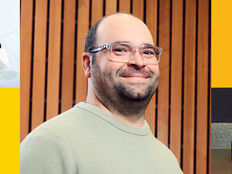This approach would mean analyzing the biometric signals that a student sends when he or she interacts with keyboards and devices — and pairing those signals with information about the student’s usual IP addresses to create a signature profile of what authentic, authorized use looks like.
“So anytime the system detects a deviation from the signature, that’s a signal for us to say, ‘We need to look into this a little further,’” Harrison says. “It would allow us to authenticate identity behind what single sign-on security software can do.”
With that said, Harrison emphasizes it’s important to assume a student is innocent until proven guilty.
“The technology gives us points of departure to explore what may or may not be a problem,” he says. “We have students worldwide. And we have many students who are deployed in the military, so their access points could look very strange on the backside of the IP address analysis. That doesn’t necessarily mean they’re cheating.”
“The goal of using these technologies isn’t to turn our students into adversaries, but to give us tools that help us protect the integrity of our resources,” Harrison adds.
Higher Education IT Leaders Win Institutional Support
Ever since UMGC embraced online learning over 20 years ago, the institution has been thinking about how to approach academic integrity in a digital environment.
They have tried myriad approaches, from using proctoring software to requiring students to take exams at a physical test center. But these strategies were not always effective, and did not ultimately align with the institution’s mission. “We moved away from proctoring over five years ago and closed all of our testing centers,” Harrison says. “We realized the best way to ensure authentic evaluation of learning is to create authentic assessments — not just have people do multiple-choice exams.”
UMGC focuses on project-based learning that uses real-world scenarios in which students encounter the kind of actions and operations they’ll engage in as part of their future careers. “The learning deliverable looks like the job that students will be doing in real life,” Harrison says.
“First of all, it’s a lot harder to cheat on authentic assessment,” Harrison says. “And second, we hope it means students don’t want to cheat on these assignments because they’re actually doing something that matters to them.”
After dedicating resources to designing better online courses and exams, UMGC also launched the Project to Combat Corruption and Attack. This initiative, which began three years ago, won them the funding to acquire and develop bots, as well as other authentication technologies in house. The university was able to accomplish this because it had already invested in robust IT infrastructure.
RELATED: Learn how to build scalable IT infrastructure that is right for your institution.
For other IT departments that are thinking of adopting a similar approach, Harrison says his advice is to get executive leadership onboard.
“We had presidential level support, and that’s critical for these things to work well,” he says. “It usually doesn’t take much work for executive leadership to endorse this type of initiative, because it is obvious how important this investment is for academic quality.”













